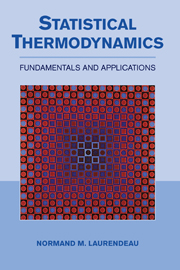Book contents
- Frontmatter
- Contents
- Preface
- 1 Introduction
- PART ONE FUNDAMENTALS OF STATISTICAL THERMODYNAMICS
- PART TWO QUANTUM MECHANICS AND SPECTROSCOPY
- PART THREE STATISTICAL THERMODYNAMICS IN THE DILUTE LIMIT
- PART FOUR STATISTICAL THERMODYNAMICS BEYOND THE DILUTE LIMIT
- PART FIVE NONEQUILIBRIUM STATISTICAL THERMODYNAMICS
- 15 Elementary Kinetic Theory
- 16 Kinetics of Molecular Transport
- 17 Chemical Kinetics
- Problem Set VII Kinetic Theory and Molecular Transport (Chapters 15–17)
- PART SIX THE ENSEMBLE METHOD OF STATISTICAL THERMODYNAMICS
- PART SEVEN APPENDICES
- Index
15 - Elementary Kinetic Theory
Published online by Cambridge University Press: 05 June 2012
- Frontmatter
- Contents
- Preface
- 1 Introduction
- PART ONE FUNDAMENTALS OF STATISTICAL THERMODYNAMICS
- PART TWO QUANTUM MECHANICS AND SPECTROSCOPY
- PART THREE STATISTICAL THERMODYNAMICS IN THE DILUTE LIMIT
- PART FOUR STATISTICAL THERMODYNAMICS BEYOND THE DILUTE LIMIT
- PART FIVE NONEQUILIBRIUM STATISTICAL THERMODYNAMICS
- 15 Elementary Kinetic Theory
- 16 Kinetics of Molecular Transport
- 17 Chemical Kinetics
- Problem Set VII Kinetic Theory and Molecular Transport (Chapters 15–17)
- PART SIX THE ENSEMBLE METHOD OF STATISTICAL THERMODYNAMICS
- PART SEVEN APPENDICES
- Index
Summary
We have previously shown that the translational energy mode for an ideal gas, even through a shock wave, invariably displays classical equilibrium behavior. In contrast, the rotational, vibrational, and electronic modes generally require significant time for re-equilibration upon disturbances in their equilibrium particle distributions. On this basis, we may expand our statistical discourse to nonequilibrium topics by grounding any dynamic redistribution on the presumption of translational equilibrium. For this reason, we now shift to elementary kinetic theory, which focuses solely on the translational motion of a gaseous assembly. Specifically, in this chapter, we consider equilibrium kinetic theory and its applications to velocity distributions, surface collisions, and pressure calculations. We then proceed to nonequilibrium kinetic theory with particular emphasis on calculations of transport properties and chemical reaction rates, as pursued in Chapters 16 and 17, respectively.
The Maxwell–Boltzmann Velocity Distribution
In Section 9.1, we showed that the translational energy mode for a dilute assembly displays classical behavior because of the inherently minute spacing between its discrete energy levels (Δε ≪ kT).
- Type
- Chapter
- Information
- Statistical ThermodynamicsFundamentals and Applications, pp. 289 - 300Publisher: Cambridge University PressPrint publication year: 2005



